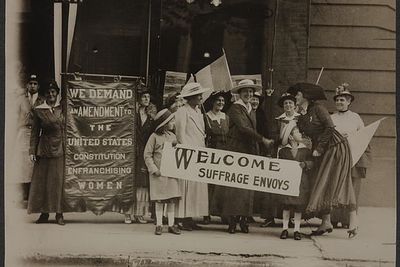Women are dominating national headlines currently as demands for equality and respect have given way to the #metoo and #timesup movements. But as the ubiquitous protest sign reads: We can't believe we're still protesting this shit.
Women's fight for equality is nothing new: A hundred years ago, brave women gathered to march and demand their right to vote and, unsurprisingly, Bay Area ladies were on the front lines. Take a look at the women's suffrage movement in San Francisco during the 1800s and early 1900s.
(San Francisco Chronicle, via FoundSF)
While we might all like to think that SF has always been the emblem of progressive politics, an editorial and illustration in the July 11, 1871 edition of the San Francisco Chronicle stunningly proves otherwise. Upon a visit to the city by iconic suffragists Susan B. Anthony and Elizabeth Cady Stanton, the Chronicle depicted the pair in an illustration akin to criminal wanted posters along with the epithet "female agitators." The paper was clear in its lack of support for the movement at the time, writing, "Mrs. Stanton is an earnest advocate of this modern idea of female suffrage, and might make converts among those who listen to one side and believe all they hear and as resolutely refuse to listen to any refutation." In February of the previous year, the Chron even ran an anti-suffrage poem that's worth a read (that is, if you can make it all the way through!).
▲(via Femilogue)
San Francisco native Maud Younger (1870-1936) gave up her life in high society to work on the front lines as a union trade organizer and suffragist. When she took a job as a waitress, the SF society lady got an up-close look at the life of working women of the day. She went on to organize the city's first waitresses' union, as well as the city's Wage Earners' Suffrage League for Working Women. She also picketed at the White House in the name of women voters.
▲(via Wikimedia)
In the winter of 1915, pro-suffrage envoys from San Francisco were greeted in New Jersey, on their way to Washington D.C. to file a petition with Congress; the women carried with them more than half a million signatures in favor of enfranchisement for women.
▲(San Francisco Call, via comstockhousehistory.blogspot.com)
Suffragists were creative in making sure they stood out and had their voices heard. The seven-seater Packard known as the Blue Liner could often be seen along the roads of Northern California, transporting speakers and singers to pro-suffrage events. In 1911, as nearly 10,000 tourists gathered in Santa Rosa for the annual state convention of the fraternal organization Native Sons of the Golden West, women activists, along with their Blue Liner, gathered in a storefront just across the carnival's ferris wheel and staged a scene to draw the in crowds. One organizer, Louise H. Wall (pictured above), recalled: "Into the pretty town of Santa Rosa we made one of these forced entries. It was during the week of the Native Sons' celebration and both the Golden Sons and the Golden Daughters assured us, with leaden emphasis, that suffrage was entirely out of place. But we felt that where so many thousands of idle people were gathered was exactly the place for us."
▲(San Francisco Call, via California Digital Newspaper Collection)
Now there's a headline. On August 24, 1911, the San Francisco Call warned readers that delegations of suffragists—including Elizabeth Roe Watson, president of the California Equal Suffrage Association; Mary Sperry, president of the Susan B. Anthony club; and Agnes Ray, president of the Equal Suffrage club of Oakland—were traveling from SF and beyond and would soon descend upon the state's capitol to push for voting rights.
▲(via Feminist Majority Foundation)
In the days leading to the October 10, 1911 vote on woman suffrage in California, it is said that suffragists were optimistic, bolstered by "the unprecedented size of the suffrage rallies," one of the largest of took place inside SF's Valencia Theater, where speakers also addressed the gathering crowd outside. Here women are seen at the suffrage committee meeting ahead of the vote for Senate Constitutional Amendment 8, also known as Proposition 4.
▲(Courtesy of bancroft.berkeley.edu)
This ribbon, from the Women Suffrage Election Day Executive Committee, is a memento from 1911, when women were granted the right to vote in California.
▲(Courtesy of Autry Museum of the American West)
In 1911, male voters narrowly gave women in California the right to vote, making the state the sixth in the nation where women could vote equally with men. The vote came nearly a decade before the 19th Amendment to the United States Constitution that enfranchised women nationally. Here a Chinese-American woman in SF is seen voting for the first time.
▲(via ThoughtCo.)
First Lady of San Francisco Annie Marshall Reid Rolph, wife of Mayor James "Sunny Jim" Rolph, places her vote at a polling station.
▲(via MtDavidson.org)
Gaining the right to vote opened the door to new roles for women in politics and civic leadership. Here we see Margaret Mary Morgan (far left), who was the first woman voted to the San Francisco Board of Supervisors, in 1920. In this photo, she is visiting Hetch Hetchy.
▲From Your Site Articles
Related Articles Around the Web
Related Articles
